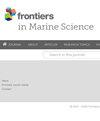首次在韩国报告苍蝇酷亚虫:苍蝇酷亚虫和马来蝇酷亚虫在韩国沿海水域的季节和空间分布
IF 3
2区 生物学
Q1 MARINE & FRESHWATER BIOLOGY
引用次数: 0
摘要
广泛分布于热带和温带水域并具有潜在毒性的底栖甲藻的分布模式正随着海洋气候的变化而改变。虽然尚未爆发过与酷氏甲藻属有关的影响人类的事件,但了解它们不断变化的分布情况并清楚地识别研究区域中的物种以应对潜在的毒性事件至关重要。在这项研究中,从济州岛和韩国东部沿海水域采集的大型藻类样本中分离出了五株酷氏藻。通过对这些分离物进行形态学和分子分析,其中一株被鉴定为库利藻(Coolia palmyrensis),这是该物种在韩国的首次报道,另外四株被鉴定为库利藻(C. malayensis)。其中一株 C. malayensis 分离自韩国东海岸的浦项,该地区以前未报告过该物种。从 2021 年到 2023 年,使用定量聚合酶链式反应(PCR)检测法对济州岛进行的监测显示,C. palmyrensis 细胞主要出现在秋季,最大密度为 242 cells g-1,并且在 2023 年观察到了越冬种群。然而,在这一地区没有观察到马来藻细胞。此外,在比济州岛更靠北的浦项和蔚山也观察到了 C. malayensis,最大细胞密度分别为 537 cells g-1 和 201 cells g-1。这些数据和我们十年来的监测经验证实,C. palmyrensis 的引入和建立以及 C. malayensis 在韩国沿海水域的栖息地转移。这项研究有助于理解气候驱动的变化与这些物种的生物地理分布之间的关系。本文章由计算机程序翻译,如有差异,请以英文原文为准。
First report of Coolia palmyrensis in Korea: seasonal and spatial distribution of C. palmyrensis and C. malayensis in Korean coastal waters
Distribution patterns of benthic dinoflagellates that are widely observed in tropical and temperate waters and have toxic potential are changing in response to ocean climate change. Although there have been no outbreaks associated with the genus Coolia affecting humans, it is crucial to understand their changing distribution and clearly identify the species in the study area to prepare for potential toxic events. In this study, five strains of Coolia species were isolated from macroalgae samples collected from Jeju Island and the eastern coastal waters of Korea. Through morphological and molecular analysis of these isolates, one strain was identified as Coolia palmyrensis , marking the first report of this species in Korea, and four strains as C. malayensis . One of the C . malayensis strains was isolated in Pohang on the eastern coast of Korea, where it had not been previously reported. From 2021 to 2023, monitoring of Jeju Island using a quantitative polymerase chain reaction (PCR) assay revealed that C . palmyrensis cells occurred mostly in autumn, with a maximum density of 242 cells g-1 , and overwintering populations were observed in 2023. However, C . malayensis cells were not observed in this area. Additionally, C . malayensis was observed in Pohang and Ulsan, located further north than Jeju Island with maximum cell densities of 537 and 201 cells g-1 , respectively. These data and our decade of monitoring experience confirmed the introduction and establishment of C . palmyrensis and habitat shift of C . malayensis in Korean coastal waters. This study provides advances for understanding of the relationships between climate-driven alterations and biogeographic distribution of these species.
求助全文
通过发布文献求助,成功后即可免费获取论文全文。
去求助
来源期刊

Frontiers in Marine Science
Agricultural and Biological Sciences-Aquatic Science
CiteScore
5.10
自引率
16.20%
发文量
2443
审稿时长
14 weeks
期刊介绍:
Frontiers in Marine Science publishes rigorously peer-reviewed research that advances our understanding of all aspects of the environment, biology, ecosystem functioning and human interactions with the oceans. Field Chief Editor Carlos M. Duarte at King Abdullah University of Science and Technology Thuwal is supported by an outstanding Editorial Board of international researchers. This multidisciplinary open-access journal is at the forefront of disseminating and communicating scientific knowledge and impactful discoveries to researchers, academics, policy makers and the public worldwide.
With the human population predicted to reach 9 billion people by 2050, it is clear that traditional land resources will not suffice to meet the demand for food or energy, required to support high-quality livelihoods. As a result, the oceans are emerging as a source of untapped assets, with new innovative industries, such as aquaculture, marine biotechnology, marine energy and deep-sea mining growing rapidly under a new era characterized by rapid growth of a blue, ocean-based economy. The sustainability of the blue economy is closely dependent on our knowledge about how to mitigate the impacts of the multiple pressures on the ocean ecosystem associated with the increased scale and diversification of industry operations in the ocean and global human pressures on the environment. Therefore, Frontiers in Marine Science particularly welcomes the communication of research outcomes addressing ocean-based solutions for the emerging challenges, including improved forecasting and observational capacities, understanding biodiversity and ecosystem problems, locally and globally, effective management strategies to maintain ocean health, and an improved capacity to sustainably derive resources from the oceans.
 求助内容:
求助内容: 应助结果提醒方式:
应助结果提醒方式:


